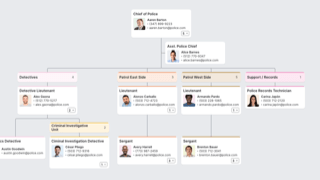Police Department Organizational Chart Template
Check out our interactive police department organizational chart. See common police department chains of command or who reports to who. With Pingboard, police department employees can see how to get in touch with each other and view each other’s profiles to see, rank, start date, and other relevant info.
Build Your Org ChartReady to get started?
Download the Police org chart template above, add your own employee data, and Import into Pingboard. Note: you’ll need a Pingboard account first. Sign up for a free trial.
Pro Tip You can build your org chart automatically. Instead of filling out a spreadsheet, you can connect your HR system to Pingboard to automatically sync employee data. Your org chart will get updated automatically every time a change happens. We integrate with ADP, Azure, BambooHR, Google Apps, Namely, Okta, and more.
Police Department Job Title Hierarchy + Most Common Roles
Chief of Police
The Police Chief is responsible for the operations and administration of the police department. The chief establishes departmental policies, procedures, and regulations and administers a comprehensive program for crime prevention and law enforcement for the city, including regulations, city codes, ordinances, and court decisions that affect the city. The chief reports to the City Manager and follows local government codes. Here are some specific tasks included in a Chief of Police’s job description:
- Act as the departmental representative to other City departments, City Manager’s Office, elected officials, and outside agencies
- Manage the development and implementation of department goals, objectives, policies, and priorities for each assigned service area
- Manage, develop, and administer the department budget; estimate funds needed for staffing, equipment, materials, and supplies; direct the monitoring and approval of expenditures
- Respond to media inquiries on police issues and policies as they relate to the community and ensure responsive, appropriate service delivery by conferring with civic, professional, and other community groups as required
Lieutenant
The Lieutenant reports to the Chief of Police and manages patrol sergeants in most police departments. Lieutenants provide direction and supervision for a section of police officers, sergeants, and professional staff. Police Lieutenants are accountable for overall police activities, and are on the scene of large fires, crimes, civil disturbances, and other major emergencies or events. This position is also responsible for organizing required training, providing administrative and policy activities in support of operations, managing assigned projects, managing operational budgets, managing inventory, overseeing the investigation of criminal activities, and performing special assignments. Here are a few common tasks found in a Lieutenant’s job description:
- Recruit new employees, recommend employee transfers, and promote, discipline, and discharge personnel
- Investigate personnel complaints and allegations made by the public or other law enforcement officers and administer disciplinary action as required with proper authorization
- Attend and participate in shift briefings
- Respond to, investigate, and assist with calls for service; perform routine patrol duties and perform traffic enforcement; locate, apprehend, arrest, and transport prisoners; supervise crime scenes and determine the need for additional and/or specialized police department units
Police Sergeant (Patrol Division)
Police sergeants sit under lieutenants and above patrol officers in most police organizational charts. They oversee the operations of the patrol division and direct, supervise, and evaluate officers assigned to their division. The Sergeant will also be responsible for completing administrative tasks, participating in community initiatives, and attending public meetings as assigned. They will also respond to calls for service, assist in conducting search and seizures, write citations, assist during emergency situations, enforce laws, statutes, and ordinances, and review and approve incident and accident reports. The Police Lieutenant assigns work to patrol officers under him/her. Here are a few more specific duties of a police sergeant:
- Supervise staff, conduct investigations, inspect staff and equipment, provide mentorship, train new officers in the field, and conduct performance evaluations
- Advise supporting officers regarding the application and interpretation of laws, review the written reports of subordinates, and make recommendations regarding the development of new policy or procedure
- Investigate complaints against personnel and respond in a manner that results in appropriate complaint resolution
- Keep other supervisors informed of important activities and critical incidents; inspect personnel and equipment; prepare routine and/or specialized reports
Police Officer (Patrol)
Police officers are typically managed by police sergeants and are the boots on the ground for police departments. Patrol officers are responsible for the protection of property and citizens. They must also uphold and enforce all penal laws of their district. Police officers may have primary responsibilities for police investigations. Here are a few tasks commonly found in their job descriptions:
- Respond to calls for police service
- Conduct preliminary & follow-up criminal and traffic investigations
- Prepare written reports and field notes of investigations and patrol activities
- Arrest and process criminals
- Testify in court
